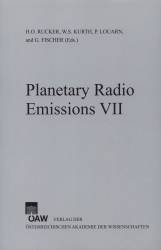
Planetary Radio Emissions VII, pp. 241-252, 2011/12/28
Proceedings of the 7th International Workshop on Planetary, Solar and Heliospheric Radio Emissions held at Graz, Austria, September 15–17, 2010

Recent Cluster WBD observations in the Earth’s auroral acceleration region have detected trapped Z mode auroral kilometric radiation while the spacecraft were entering a deep density cavity. The Z mode has a clear cutoff at the local upper hybrid resonance frequency, while RX mode radiation is detected above the RX mode cutoff frequency. The small gap between the upper hybrid resonance and the RX mode cutoff frequencies is proportional to the local electron density as expected from cold plasma theory. The width of the observed gap provides a new sensitive measure of the ambient electron density. In addition, the relative intensities of RX and Z mode radiation provide a sensitive probe of the plasma ß = ?pe/Oce at the source since the growth rates, although identical in form, have different ranges of allowed resonant radii which depend on ß. In particular, the RX mode growth is favored for low ß, while the Z mode is favored at higher ß. The observed mode intensities and ß’s appear to be consistent with this model, and favor generation of Z mode at the source over models in which Z mode is generated by mode-conversion at cavity boundaries. These are the first multi-point direct measurements of mode-specific AKR propagation in the auroral acceleration region of any planet.